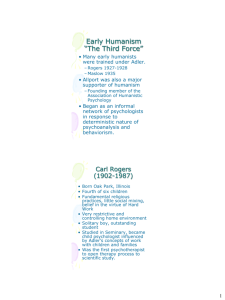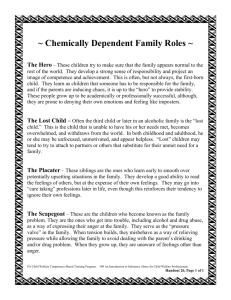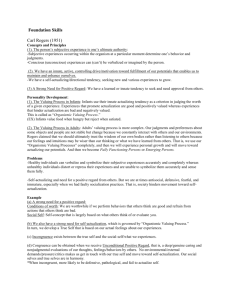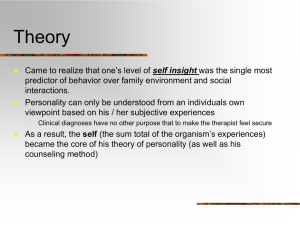Chapter 13
advertisement
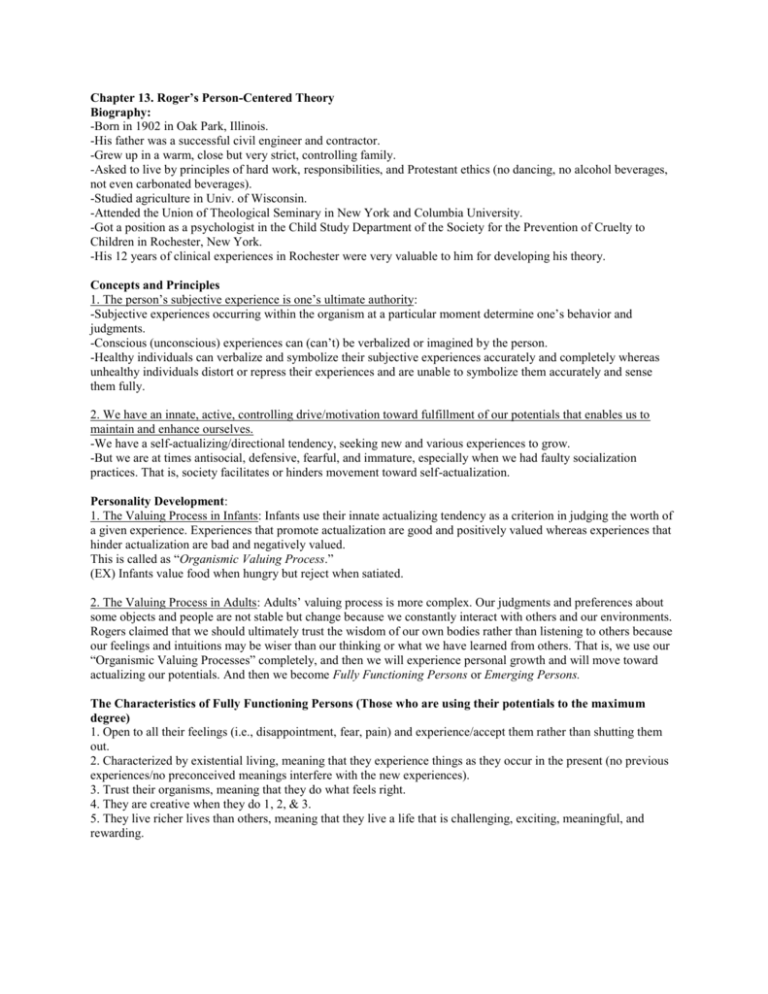
Chapter 13. Roger’s Person-Centered Theory Biography: -Born in 1902 in Oak Park, Illinois. -His father was a successful civil engineer and contractor. -Grew up in a warm, close but very strict, controlling family. -Asked to live by principles of hard work, responsibilities, and Protestant ethics (no dancing, no alcohol beverages, not even carbonated beverages). -Studied agriculture in Univ. of Wisconsin. -Attended the Union of Theological Seminary in New York and Columbia University. -Got a position as a psychologist in the Child Study Department of the Society for the Prevention of Cruelty to Children in Rochester, New York. -His 12 years of clinical experiences in Rochester were very valuable to him for developing his theory. Concepts and Principles 1. The person’s subjective experience is one’s ultimate authority: -Subjective experiences occurring within the organism at a particular moment determine one’s behavior and judgments. -Conscious (unconscious) experiences can (can’t) be verbalized or imagined by the person. -Healthy individuals can verbalize and symbolize their subjective experiences accurately and completely whereas unhealthy individuals distort or repress their experiences and are unable to symbolize them accurately and sense them fully. 2. We have an innate, active, controlling drive/motivation toward fulfillment of our potentials that enables us to maintain and enhance ourselves. -We have a self-actualizing/directional tendency, seeking new and various experiences to grow. -But we are at times antisocial, defensive, fearful, and immature, especially when we had faulty socialization practices. That is, society facilitates or hinders movement toward self-actualization. Personality Development: 1. The Valuing Process in Infants: Infants use their innate actualizing tendency as a criterion in judging the worth of a given experience. Experiences that promote actualization are good and positively valued whereas experiences that hinder actualization are bad and negatively valued. This is called as “Organismic Valuing Process.” (EX) Infants value food when hungry but reject when satiated. 2. The Valuing Process in Adults: Adults’ valuing process is more complex. Our judgments and preferences about some objects and people are not stable but change because we constantly interact with others and our environments. Rogers claimed that we should ultimately trust the wisdom of our own bodies rather than listening to others because our feelings and intuitions may be wiser than our thinking or what we have learned from others. That is, we use our “Organismic Valuing Processes” completely, and then we will experience personal growth and will move toward actualizing our potentials. And then we become Fully Functioning Persons or Emerging Persons. The Characteristics of Fully Functioning Persons (Those who are using their potentials to the maximum degree) 1. Open to all their feelings (i.e., disappointment, fear, pain) and experience/accept them rather than shutting them out. 2. Characterized by existential living, meaning that they experience things as they occur in the present (no previous experiences/no preconceived meanings interfere with the new experiences). 3. Trust their organisms, meaning that they do what feels right. 4. They are creative when they do 1, 2, & 3. 5. They live richer lives than others, meaning that they live a life that is challenging, exciting, meaningful, and rewarding. The Characteristics of Emerging Persons (People of the future): 1. Honest and open-minded (i.e., They reject the sham and hypocrisy of government, are open about their sexual relationships, and are opposed to highly structured bureaucracies). 2. Indifferent to material comforts and rewards (i.e., Not power-hungry, not achievement-hungry, tend to relate to people in egalitarian ways). 3. Caring others (i.e., not for money/praise but for just want to help others). 4. A deep distrust of cognitively based science and technology (i.e., significant discovery involves feelings rather than thinking). 5. Trust their own experiences and distrust all external authority (i.e., they do not obey laws just for the sake of obeying but they obey when it feels right). 6. Always in process, meaning that they expect to change unjust political and social situations. The Social Self and the True Self: 1. A Strong Need for Positive Regard: We have a learned or innate tendency to seek and need approval from others. 2. Conditions of worth: We are worthwhile if we perform behaviors that others think are good and refrain from actions that others think are bad. 3. Social Self: Self-concept that is largely based on what others think of or evaluate you. 4. We also have a strong need for self-actualization, which is governed by “Organismic Valuing Process.” In turn, we develop a True Self that is based on our actual feelings about our experiences. 5. Incongruence exists between the true self and the social-self/what we experiences. 6. Congruence can be obtained when we receive Unconditional Positive Regard, that is, a deep/genuine caring and nonjudgmental evaluations of our thoughts, feelings/behaviors by others. No environmental/external demands/pressure/critics makes us get in touch with our true self and move toward self-actualization. Our social selves and true selves are in harmony. *When incongruent, more likely to be defensive, pathological, and fail to actualize self. Empirical Support for the Self-Theory 1. Chodorkoff (1954) Hypothesis 1: The greater the agreement between one’s self description and a description of the person by others, the less defensive the person is. (a) Self-description was obtained by two projective tests (assuming that their responses to the projective tests reflect their own assessment at an organismic level). (b) Description by others was obtained by clinical judgments (clinician’s ratings). (c) Compute the discrepancy between (a) and (b). (d) Tachistoscope: Present threatening (bitch, whore) or non-threatening (chair, table) words for a very short period of time (20 ms) and ask them to recognize the word. The longer they recognize the threatening words compared to the non-threatening words, the more they employ perceptual defenses. (e) The higher (c) is, the more (d) is. Hypothesis 2: The greater the agreement between the personal and objective descriptions, the greater the person’s personal adjustment. (a) A list of adjectives (i.e., kind, confident) was presented to clinicians and ask them to chose adjective that describe their subject participants. The more adjectives the clinicians choose, the more the subjects are socially adjusting. (b) Those with higher (a) are likely to show less (d). 2. Q-sort: It measures the discrepancies between the true-self and the social-self. (a) Ask clients to sort (arrange) a large number of self-referent statements on a 7-point scale (i.e., “like me” “not like me”). (b) Ask them to re-sort the statements in terms of their ideal selves on a 7-point scale. (c) Correlation between (a) and (b). (d) Lower (d), more discrepancies. (e) After therapy, larger (d). Therapeutic Implications -Four major techniques had been used by therapists: ordering/forbidding, exhortation (admonishing), suggestion (reassurance/encouragement), and adviceToo directive, external demands. -Clients have great capacity for change and will change in constructive ways if therapists create the appropriate conditions for growth. -The conditions include: (a) They need to be in psychological contact (each makes an impact on the phenomenological field of the other) (b) The client is in a state of incongruence and feels anxious about it (motivation). (c) The therapist is congruent in the relationship (i.e., present one’s true self/feelings. Genuine. “I feel bored rather than you are a boring person.”) (d) The therapist experiences unconditional positive regard for the client (not judgmental and evaluative). (e) The therapist experiences an empathetic understanding of the client’s internal frame of reference (accurately perceives the clients’ complex feelings and communicate them to the client). (f) The client perceives both (d) and (e). -And clients will change: (a) More expression of their feelings (b) Accurate assessment of the meanings of their feelings. (c) Can see the incongruity between the self-concepts and their experiences. (d) Reorganize their self-concepts. (e) More congruity (f) More organismic process Educational implications Rogers was against the following assumptions. (a) Students can’t be trusted to pursue their own educational goals. (b) Creative people develop from passive learners (i.e., professor vs. students). (c) Evaluation is education (i.e., Prevents students from conducting the independent learning necessary to a creative life). -Students should set their own standards within a context of minimal evaluation by authority figures, but 1994 federal law demands that school officials set higher standards and test students frequently to ensure that they eventually attain required standards. Implications for Marriage -Rogers was against the following ideas: (a) “I am more concerned for you than I am for myself.” (i.e., Uncritical willingness to sacrifice one’s identity to please the other) (b) “We will work hard on our marriage.” (i.e., The problem may be persistentdestructive). (c) “We pledge ourselves to each other until death do us apart.”(i.e., No mater what? The cost might be too much). -Idealistic Marriage (a) Take risks and explore differences to deepen the bonds of partnership. (b) Open communication with mutual listening. (c) Appreciate the value of separateness (each has separate needs and desires) (d) Get rid of traditional roles of women and men. (e) Satellite Relationships: Relationship formed outside the marriage that nay or may not involve sexual intimacy. Great pain but may enrich growth (both intellectually and emotionally).
